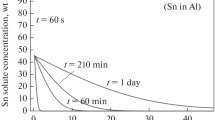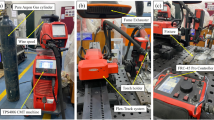Abstract
Gold-aluminum ball bonds were thermally exposed at constant elevated temperatures, and the resultant phase transformations studied in detail. The as-bonded microstructure of a Au-Al ball bond essentially consisted of a reaction zone (termed “alloyed zone” (AZ) in the as-bonded condition) between the Au bump and the bonded Al metallization. It is the growth of the reaction zone between the Au bump and the bonded Al metallization and also the nonbonded Al metallization during thermal exposure that gave rise to the various phase transformations. Au4Al, Au8Al3, and Au2Al are the predominant phases that grew across the ball bond until the bonded Al metallization is available to take part in the interdiffusion reactions. After the complete consumption of the bonded Al metallization, the Au-Al phases reverse transformed resulting in the formation of the Au4Al phase in the entire reaction zone across the ball bond (RZ-A). The lateral interdiffusion reactions resulted in the nucleation and the growth of all of the Au-Al phases given by the phase diagram. Kidson’s analysis and Tu et al.’s treatment were extended to a five-phase binary system to explain the phase transformations in thermally exposed Au-Al ball bonds. It is possible for all of the Au-Al phases to grow across a ball bond uninhibited as long as the bonded metallization is available. However, the supply limitation of the bonded metallization gives rise to reverse transformations where Al-rich phases transform to Au-rich phases and eventually result in the formation of the Au4Al phase in the entire RZ-A. If infinite time is allowed, Au4Al would dissolve; the extent of which is dependent on the solubility of Al in Au. No supply of Au lateral to the bond causes the reverse transformation of the Au4Al phase, giving rise to the lateral growth of the remaining Au-Al phases. If infinite time is allowed, the lateral phase transformations would result in the formation of a phase that is dependant on the relative proportion of Au and Al present in the nonbonded metallization (NBM) and Au4Al below the void line. Hence, the presence of a phase in a particular location of a ball bond is dependent on the time and temperature of thermal exposure.
Similar content being viewed by others
References
C. Weaver and L.C. Brown, Philos. Mag. 7, 1 (1962).
D.P. Kolesnikov, A.F. Andrushko, and Y. Sukhinina, Fizika Metallurgica 34, 529 (1972).
R.A. Fouracre, Thin Solid Films 135, 189 (1986).
M.H. Francombe, A.J. Noreika, and W.J. Takei, Thin Solid Films 1, 353 (1967–1968).
W.J. Takei and M.H. Francombe, Solid State Electron. 11, 205 (1968).
E. Philofsky, Solid State Electron. 13, 1391 (1970).
S.U. Campisano, G. Foti, E. Rimini, S.S. Lau, and J.W. Mayer, Philos. Mag. 31, 903 (1975).
G. Majni, C. Nobili, G. Ottaviani, and M. Costato, J. Appl. Phys. 52, 4047 (1981).
G. Majni, C. Nobili, G. Ottaviani, and M. Costato, J. Cryst. Growth 47, 583 (1979).
I.A. Blech and H. Sello, J. Electrochem. Soc. 113, 1052 (1996).
T. Uno and K. Tatsumi, J. Jpn. Inst. Met. 63, 828 (1999).
M. Kashiwabara and S. Hattori, Rev. Electric. Comm. Lab. 17, 1001 (1969).
V. Koeninger, H.H. Uchida, and E. Fromm, IEEE Trans. Comp., Hybrids Manufacturing Technol. 18, 835 (1995).
L. Maiocco, D. Smyers, S. Kadiyala, and I. Baker, Mater. Charact. 24, 293 (1990).
R.A. Clarke and V. Lukatela, Int. J. Microcircuits Electron. Packaging 15, 87 (1992).
G.V. Clatterbaugh, J.A. Weiner, and K. Charles, Jr., IEEE Trans. Comp., Hybrids Manufacturing Technol. 7, 349 (1984).
K. Dittmer, S. Kumar, and F. Wulff, Int. Conf. on High Density Packaging and MCMs (Reston, VA: SPIE, 1999), pp. 403–408.
N.J. Noolu (Ph.D. dissertation, The Ohio State University, 2001).
G.V. Kidson, J. Nucl. Mater. 3, 21 (1961).
K.N. Tu, J.W. Mayer, and L.C. Feldman, Electronic Thin Film Science for Electrical Engineers and Materials Scientists (New York: Macmillan Publishing Company, 1992).
K.N. Tu, G. Ottaviani, U. Gosele, and H. Foll, J. Appl. Phys. 54, 758 (1983).
K.N. Tu, Advances in Electronic Materials, ASM Materials Science Seminar (Metals Park: OH, ASM, 1984) p. 147.
J. Phase Equilibria 12, 11 (1991).
T.B. Massalski, ed., Binary Alloy Phase Diagrams (Materials Park, OH: ASM International, 1995).
A.D. Smigelskas and E.O. Kirkendall, Trans. AIME 171, 130 (1947).
T. Ramsey, C. Alfaro, and H. Dowell, Semicond. Int. 4, 7 (1991).
Author information
Authors and Affiliations
Rights and permissions
About this article
Cite this article
Noolu, N., Murdeshwar, N., Ely, K. et al. Phase transformations in thermally exposed Au-Al ball bonds. J. Electron. Mater. 33, 340–352 (2004). https://doi.org/10.1007/s11664-004-0141-7
Received:
Accepted:
Issue Date:
DOI: https://doi.org/10.1007/s11664-004-0141-7




